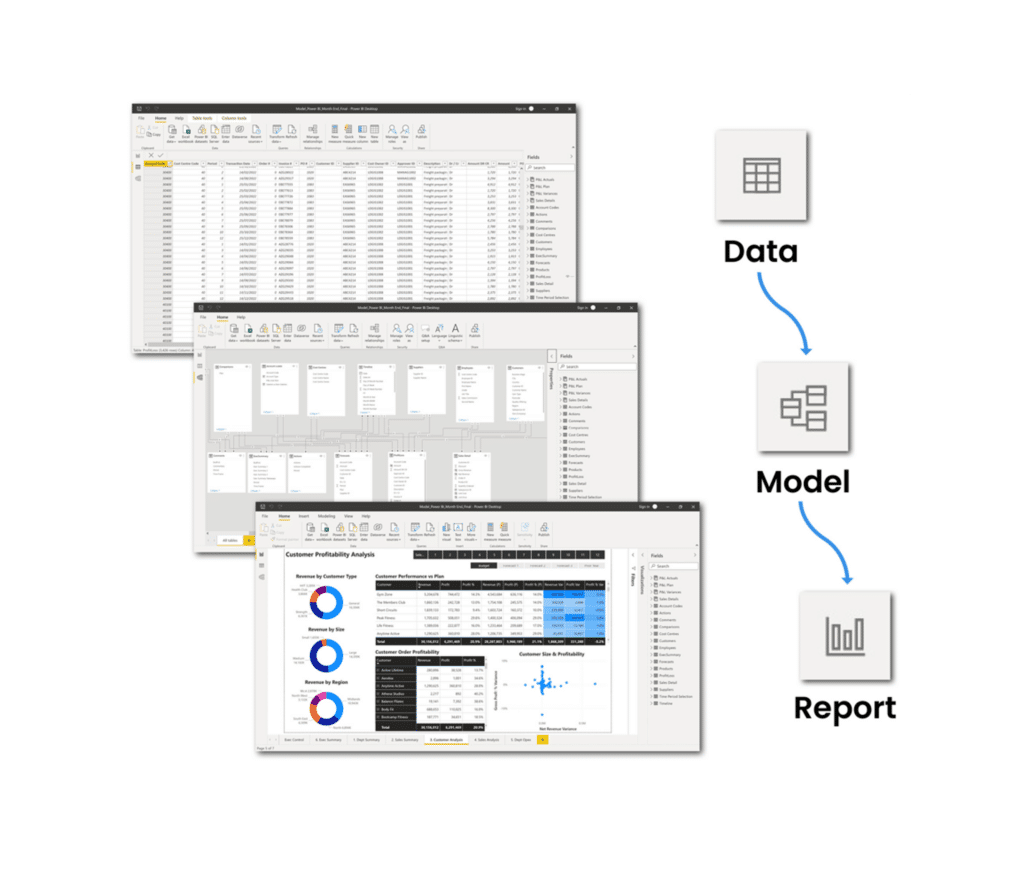The 8 Criteria of Successful Performance Measurement


Table of Contents
In this post we delve into the complex world of key performance indicators (KPIs), objectives and key results (OKRs), and other performance indicators, highlighting their vital role in bridging the gap between strategy and value creation.
We’ll explore how these tools are used to guide businesses towards their goals, making abstract strategies tangible and shedding light on the inputs and processes that drive outcomes. We’ll also discuss the power of influence in steering KPIs and the need for a balanced set of organizational metrics that span across all departments and functions.
Linking Strategy to Value: Navigating KPIs, OKRs, and Performance Indicators
To bridge the gap between strategy and value creation, businesses must use effective measurement techniques like KPIs, OKRs, and performance indicators. KPIs are divided into strategic (long-term, high-level metrics) and operational (daily activity metrics). For example, a strategic KPI for a software company might be “Increase Market Share by X%” and an operational KPI could be “Average Resolution Time for Customer Support Tickets”.
OKRs link strategic intent with tangible outcomes. The objectives are qualitative and inspirational, while key results are specific and measurable. For instance, an objective could be “Become a Leader in Sustainable Packaging” and a key result might be “Reduce Plastic Usage by 30%”.
Performance indicators offer insight into the inputs and processes that drive outcomes. Leading indicators predict future success, like “Number of Footfall Engagements”, while lagging indicators reflect past performance, such as “Monthly Sales Revenue”. Measuring more than just outcomes helps identify opportunities for improvement and encourages risk-taking and innovation.
In essence, businesses should understand strategic and operational KPIs, use OKRs to connect strategy and execution, and value performance indicators beyond mere outcomes to achieve enduring success.
The Crucial Connection: Why Your KPIs Must Impact Performance
In the modern business landscape, success isn’t just about setting goals but devising a strategy that brings those goals to life. Central to this strategy are Key Performance Indicators (KPIs), the compass guiding an organization towards its objectives. However, not all KPIs are equal; they must directly impact performance to drive meaningful progress.
Think of KPIs as the rudder steering the ship of your organization. Small changes might lead to minor shifts, but significant alterations in KPIs can transform the course. For instance, a retail company aiming to boost customer satisfaction scores must focus on transformative changes like enhancing the quality of customer interactions rather than minor improvements.
In the realm of limited resources, prioritization is key when selecting KPIs. Not all metrics contribute equally towards achieving overarching goals, hence the need for ranking KPIs based on their impact. High-impact KPIs have the most significant influence on outcomes and should be the primary focus.
Devoting time and resources to high-impact KPIs maximizes resource allocation and provides a clear direction for employees. By prioritizing these KPIs and recognizing their potential to generate transformative changes, organizations can navigate towards sustained success with greater efficiency and focus.
The Power of Influence: Why Your Ability to Impact KPIs Matters
Key Performance Indicators (KPIs) are vital in guiding an organization towards its goals. However, the ability to influence KPIs is equally important. Some KPIs respond more readily to your actions than others. Understanding this can guide strategic decisions and maximize impact.
Consider KPIs as levers that can steer your organisation’s trajectory. For instance, a marketing team can significantly influence website traffic by optimizing content, running ad campaigns, and leveraging social media. However, factors like market trends or competitors might limit this influence.
Effectively allocating resources involves ranking KPIs based on their influence – High, Medium, and Low. High-influence KPIs directly shape outcomes and should be prioritized to optimize efforts for maximum impact. For example, if a marketing team’s actions have a pronounced impact on driving website traffic, then “Website Traffic” becomes a high-influence KPI.
Focusing on high-influence KPIs optimizes resource allocation, fosters empowerment, and instills accountability. Recognizing your ability to influence KPIs can lead to strategic decisions that drive success. This approach ensures that your actions resonate where they matter most.
Achieving Clarity: The Need for a Balanced Set of Organizational Metrics
In today’s complex business landscape, achieving success requires a balanced, holistic set of organizational metrics. These should span the entire organization, incorporating different departments and functions, and balancing financial and non-financial perspectives.
Just like in a symphony where every instrument contributes to the whole, each department in an organization plays a vital role. Metrics should therefore capture the performance of all areas, facilitating strategic decision-making by preventing tunnel vision and fostering collaboration.
Both leading (anticipatory) and lagging (retrospective) indicators are essential. Metrics such as customer engagement can hint at future satisfaction levels, while others like quarterly revenue reflect past strategies’ effectiveness. This balance allows course adjustments while evaluating past decisions.
While financial metrics are important, they don’t reflect non-financial aspects like customer satisfaction, employee engagement, or environmental sustainability. A comprehensive metrics framework incorporates both, providing a more holistic understanding of organizational health.
Finally, both subjective (perceptions, attitudes) and objective (quantifiable data) metrics are critical. They offer insight into the emotional pulse of the organization and the tangible realities, respectively.
A balanced set of metrics thus offers leaders clarity to make informed, strategic decisions for sustained success.
The Art of Focus: Why Limiting KPIs is Key to Success
In our data-heavy business environment, limiting Key Performance Indicators (KPIs) enhances clarity and effectiveness. A surplus of metrics can lead to confusion and scattered focus. A concise set of KPIs acts as a compass, directing efforts towards vital objectives and reducing the risk of data overwhelm.
The principle of quality over quantity applies to KPIs. Too many can result in a superficial understanding of performance, hindering deep insights. A select few KPIs allows for deeper analysis and trend identification, leading to actionable strategy development.
Quick, strategic decision-making is essential in today’s fast-paced business landscape. A focused set of KPIs provides clear performance insights, facilitating rapid response to challenges and opportunities. It also makes discussions more purposeful, centered around crucial metrics.
Business environments are dynamic, necessitating regular reassessment and refinement of KPIs to ensure they align with evolving goals. Limiting KPIs fosters clarity, quality, agility, and drives success. Amidst data overflow, a focused set of metrics simplifies complexity and enhances decision-making ability.
Baseline performance and set appropriate targets
Baselining current performance and setting targets for Key Performance Indicators (KPIs) are pivotal to effective performance management. The baseline provides a snapshot of the organization’s current state, revealing strengths, weaknesses, and areas for improvement. This understanding is crucial for setting realistic targets and designing strategies to enhance performance.
Targets serve as lighthouses, providing a clear goal to work towards. They align with organizational objectives, creating a shared sense of purpose, and motivating employees. Regularly comparing actual performance against these targets enables organizations to assess their progress.
Recognizing that not all deviations from targets are equal, tolerances are set. These define the acceptable variation range around the target, helping distinguish between minor fluctuations and significant deviations that require immediate attention.
Performance management is a cycle of planning, executing, measuring, and adapting. If performance consistently falls outside acceptable tolerances, it signals the need for strategy or resource adjustments. This continuous improvement approach keeps the organization agile and responsive.
In summary, baselining, setting targets, and defining tolerances for KPIs provide clarity, direction, and a mechanism for monitoring progress, equipping your organization with tools to navigate towards success.
The Power of Alignment: Cascading KPI Measurement Through the Organization
Cascading Key Performance Indicators (KPIs) through an organization is vital for alignment, empowerment, accountability, and strategic clarity. It translates high-level strategic goals into actionable KPIs at every level, from leadership to frontline teams. It’s like a symphony orchestra where each musician follows the conductor’s lead, ensuring harmony throughout the performance.
Cascading KPIs transform abstract strategies into tangible actions, enabling everyone to see how their efforts contribute to the big picture. This fosters a sense of purpose and ownership and creates a scoreboard that quantifies success, instilling accountability.
Cascading KPIs also provide strategic clarity and facilitate agile decision-making. They act as a beacon, illuminating the strategic path and allowing quick strategy adjustments based on real-time KPI data.
Different levels within the organization require different KPIs. High-level outcomes like revenue growth might be monitored by executives, while operational teams may track efficiency-related KPIs. By measuring relevant KPIs at each level, individuals can directly influence the outcomes they’re responsible for.
In conclusion, cascading KPIs bridges the gap between strategy and execution, fostering a culture of purpose, clarity, and collaboration. It empowers individuals and guides decision-making, creating a cohesive and successful organization primed to achieve its goals.
KPI Communication is a two way process
KPI communication is a dynamic, two-way process that involves the sharing of information and gathering of feedback. KPIs, which are indicators of an organization’s performance, need context for proper interpretation. Leaders provide this by explaining the significance of each metric and how it aligns with strategic goals. Employees, on the other hand, offer insights about their work that may affect KPI interpretation.
This two-way communication process fosters a shared understanding, preventing confusion and misdirected efforts. It also creates a feedback loop that can improve how KPIs are defined, measured, and used. For instance, team feedback can lead to more accurate metrics that better guide decision-making.
Two-way KPI communication is key to alignment and engagement. It ensures everyone understands their role in achieving strategic objectives, fostering a sense of ownership and motivation. It also helps navigate changes and challenges, as teams can provide valuable insights about market shifts or internal issues affecting KPIs.
Furthermore, engaging employees in KPI discussions empowers them to take ownership of their performance. It encourages a culture of continuous improvement, where teams can discuss challenges and collaboratively find solutions. In summary, two-way KPI communication is not just about sharing data; it’s a strategic tool that drives alignment, engagement, and organizational success.
Want to learn more about KPIs?
Join our September Quest..








Responses